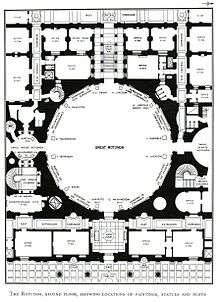Columbus Doors
| Columbus Doors | |
|---|---|
 | |
| Artist | Randolph Rogers |
| Year | 1855–61 |
| Type | Bronze |
| Dimensions | 510 cm × 300 cm (200 in × 117 in) |
| Location |
United States Capitol Washington, D.C., United States |
Columbus Doors (1855–1861), also known as the Rogers Doors, are a pair of massive bronze doors modeled by sculptor Randolph Rogers for the East Front of the United States Capitol in Washington, DC. They open into the Rotunda, and depict events from the life of Christopher Columbus.
History
.jpg)
Rogers, an expatriate American artist trained and living in Italy, was a Neoclassical sculptor noted for his carved works in marble. He visited the United States in 1855, and was awarded the commission for the doors. He had never done anything on this scale, and was not known for working in bronze.
Rogers's sculptural theme was Scenes from the Life of Columbus. Each door has four panels illustrating significant events, and the semi-circular transom above the pair illustrates Columbus landing in the New World. The border surrounding the doors and transom is adorned with statuettes of figures who participated in the Columbus story and nautical items such as anchors and rudders. Figures around the outer rim represent Asia, Africa, Europe and America.
Between 1856 and 1858, Rogers modeled the doors first in clay, then in plaster. They were cast in bronze at the Royal Bavarian Foundry in Munich, Germany, 1860-61. Because of delays in transportation related to the American Civil War, they did not arrive in the United States until 1863. They were installed on the East Front in 1871.[1]
With transom, the doors are 16 ft 8 in tall, and 9 ft 9 in wide. They weigh approximately 20,000 pounds (10 tons).
They were most recently conserved in 1988.
East Front Extension

The Capitol's East Front was extended between 1958 and 1962. A new exterior wall was built 32.5 feet east of the old exterior wall, and the space between them became the Main Lobby, offices and the East Extension Corridor. Remaining in place, the once-exterior Columbus Doors became interior doors, opening from the newly created Main Lobby into the Rotunda.[2]
Panels
 Columbus door
Columbus door.jpg) Left door: Columbus before the Council at Salamanca (1487).
Left door: Columbus before the Council at Salamanca (1487)..jpg) Columbus Leaves La Rabida for the Spanish Court (1492).
Columbus Leaves La Rabida for the Spanish Court (1492)..jpg) Columbus at the Court of Ferdinand and Isabella (1492).
Columbus at the Court of Ferdinand and Isabella (1492)..jpg) Columbus Starts from Pavos (1492).
Columbus Starts from Pavos (1492)..jpg) Transom: Landing of Columbus in the New World (1492).
Transom: Landing of Columbus in the New World (1492)..jpg) Right door: Columbus's First Encounter with the Indians (1492).
Right door: Columbus's First Encounter with the Indians (1492)..jpg) Triumphal Entry of Columbus into Barcelona (1493).
Triumphal Entry of Columbus into Barcelona (1493)..jpg) Columbus in Chains (1500).
Columbus in Chains (1500)..jpg) Deathbed of Columbus (1506).
Deathbed of Columbus (1506).
See also
Notes
- Architect of the Capitol, Compilation of Works of Art and Other Objects in the United States Capitol (1965).
- Architect of the Capitol, Art in the United States Capitol (Washington, DC: Smithsonian Institution Press, 1974).
- ↑ Architect of the Capitol Webpage
- ↑ 1958-62 Extension Archived 2012-01-26 at the Wayback Machine. from Architect of the Capitol.
External links
- Columbus Doors from Smithsonian Institution Reference Information System (SIRIS).